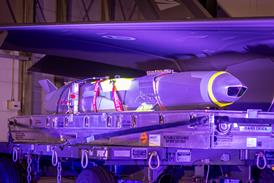Manufacturer points to financing scheme to fund USAF bomber overhaul to replace ageing Pratt & Whitney TF33s
Boeing has again tested the US Air Force's interest in re-engining the B-52H fleet, this time pointing to a unique financing scheme and growing support in Congress.
In 1996, the USAF chose not to act on Boeing's unsolicited proposal to refit the B-52H fleet with Rolls-Royce RB211 high-bypass turbofan engines, replacing the 50-year-old Pratt & Whitney TF33s.
The Defense Science Board revisited the issue in 2002 and found flaws in the air force's cost-benefit analysis, which failed to account for the heavy premium on fuel delivery using aerial tankers (a gallon of fuel costing $1.17 on the ground soars to $20.07 for mid-air refuelling, according to air force statistics).
As the cost to overhaul the TF33 powerplants has tripled within a decade to a projected $832,000 in fiscal year 2004, a joint USAF/Boeing study obtained by Flight International is recommending the launch of a $3.95-4.65 billion re-engining effort.
The goal would be to obtain operating cost savings of $11-15 billion, while at the same time increasing B-52H combat range by 22% and loiter time on station by 200%.
The study, however, threatens R-R's status as the favoured engine candidate, proposing a competition between the RB211 and the Pratt & Whitney F117 (PW2000), plus an eight-engine variant using the GE /Snecma CFM56.
The study goes a step further by proposing a novel funding plan centred on a little-known government financing mechanism called an Energy Savings Performance Contract (ESPC), which allows federal agencies to use energy savings accumulated over 20 or more years to pay contractors for efficiency upgrades. "The annual cost of financing re-engining under a successful ESPC would be no greater than the current cost for operating, maintaining, sustaining and overhauling the B-52H's current engines throughout its remaining life," the study concludes.
The ESPC route would avoid a battle for precious procurement funds, and despite the growing financial burden of maintaining TF33s, re-engining is low on the list of air force priorities for B-52H upgrades funded by normal procurement channels.
By law, however, ESPCs cannot be used to pay for improvements to mobile assets or weapons, only federal buildings. But a bill introduced in Congress on 17 October proposes to change this, allowing the US Department of Defense to enlist ESPCs for up to 10 "non-building" programmes. The bill is backed by a bi-partisan mix of four Republicans and four Democrats.
Source: Flight International


























